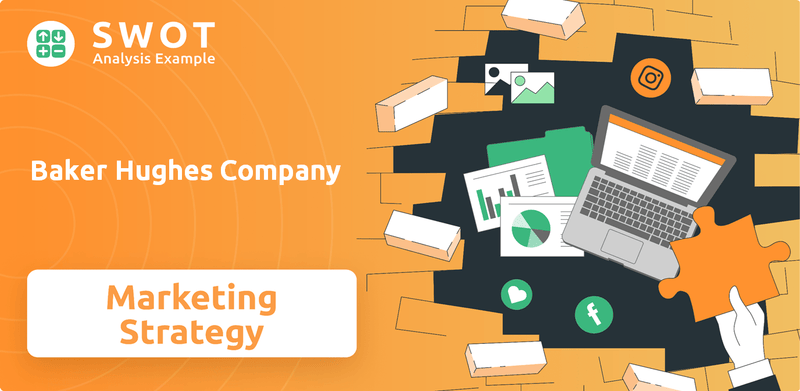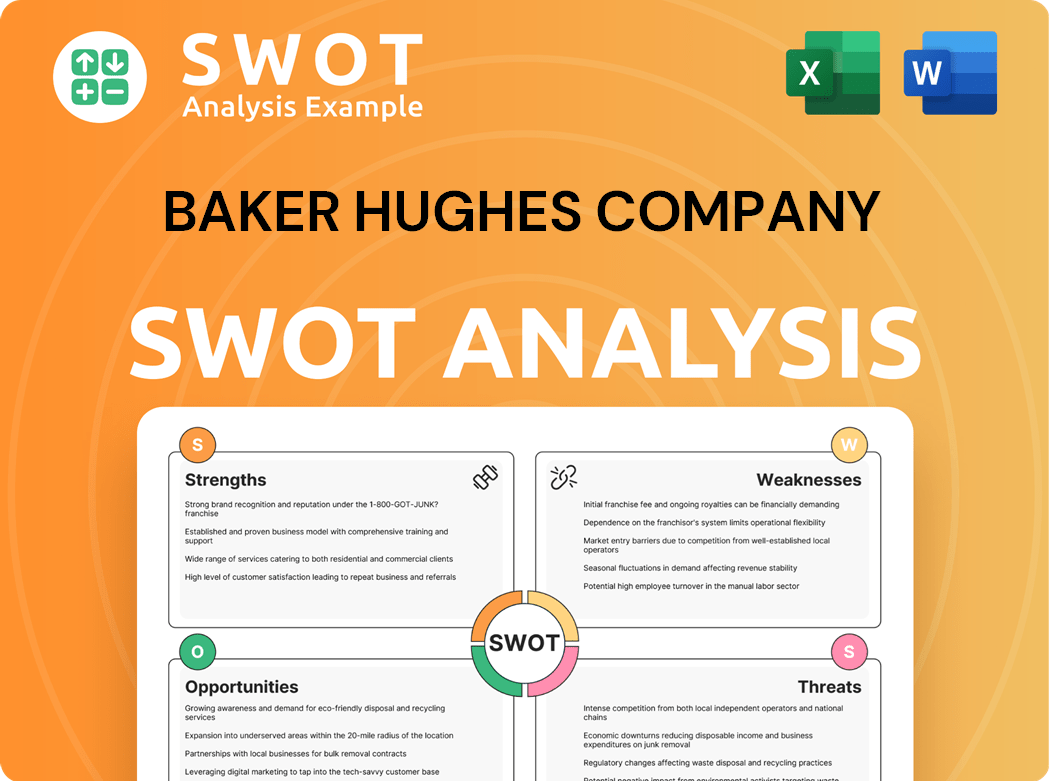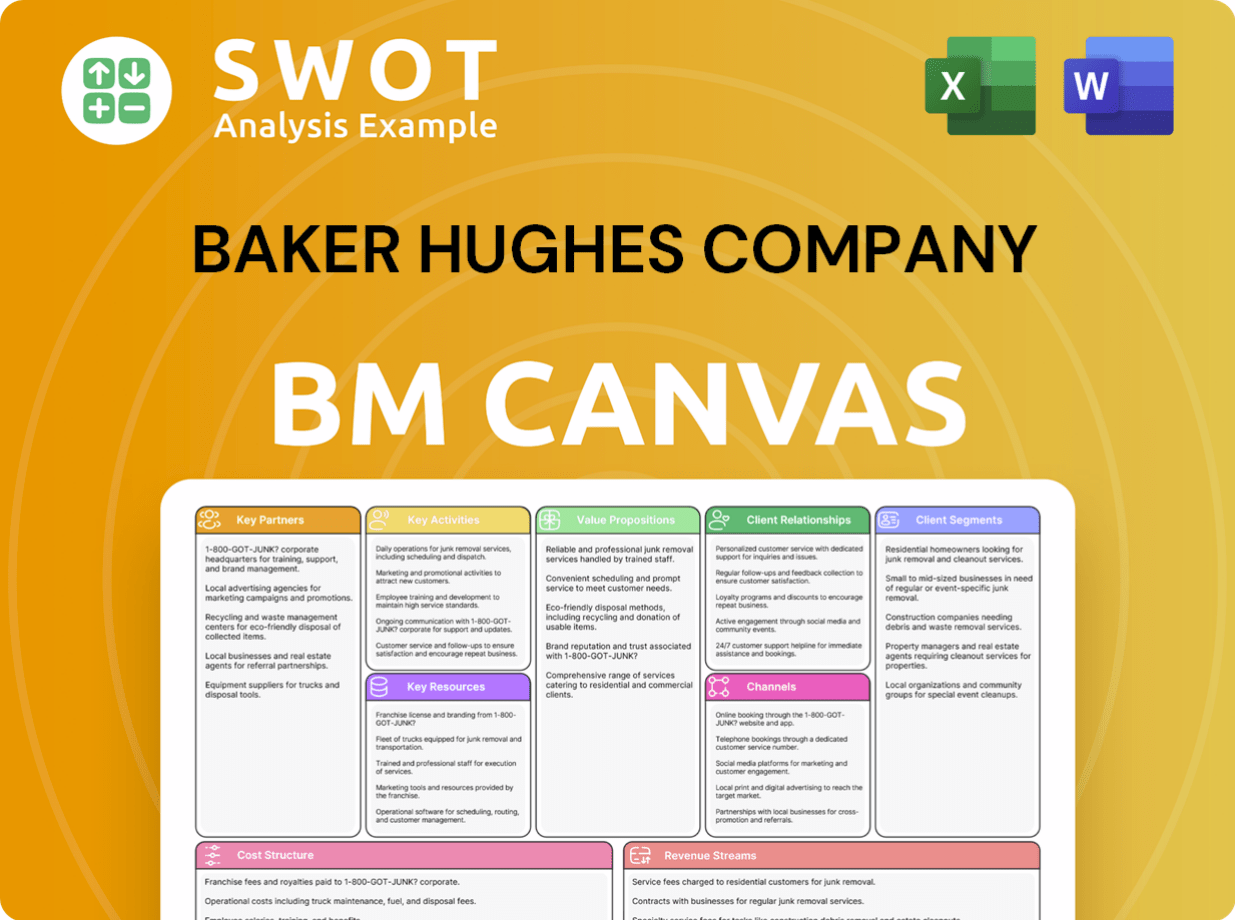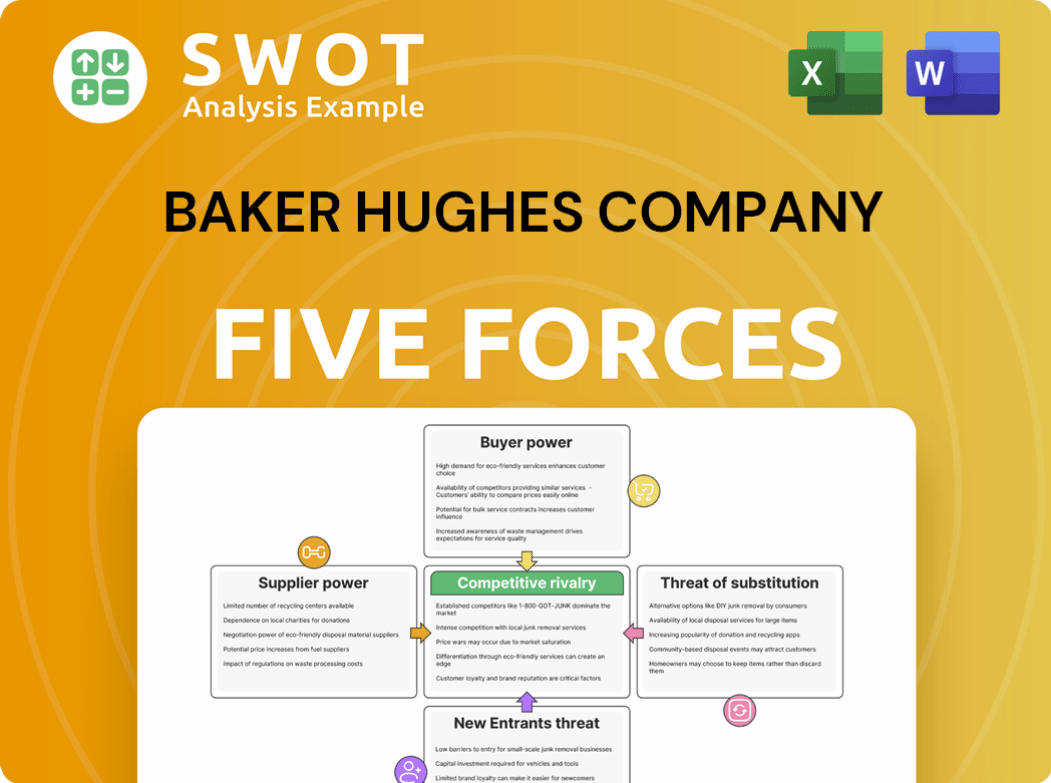Baker Hughes Company Bundle
How is Baker Hughes Navigating the Energy Transition?
Baker Hughes, a century-old energy technology leader, is undergoing a remarkable transformation. Witness its strategic evolution from an oilfield service provider to a champion of sustainable solutions, driven by a bold rebranding in 2018. This shift is crucial, as the company aims to achieve net-zero carbon emissions by 2050.

This analysis dives deep into the Baker Hughes Company SWOT Analysis, exploring its dynamic sales and marketing approach. We'll uncover how Baker Hughes is adapting its Baker Hughes sales strategy and Baker Hughes marketing strategy to thrive in the evolving energy sector. Discover the innovative Baker Hughes strategy behind its success, including its digital marketing initiatives and customer acquisition strategies, and how it's reshaping its brand positioning and market share analysis in the face of changing demands.
How Does Baker Hughes Company Reach Its Customers?
The sales channels of Baker Hughes are primarily structured around a direct sales force, targeting a global customer base that includes independent oil and gas companies, national oil companies, and broader industrial sectors. This approach is characterized by a strong regional focus, with local teams strategically positioned near customers. These teams are supported by centers of excellence focused on specific product lines, allowing for tailored solutions to meet the unique demands of each market.
Baker Hughes' strategy also involves digital adoption and omnichannel integration. While direct sales remain central, the company leverages online digital platforms and partner distributor networks. The company uses its website, bakerhughes.com, as a central hub for digital marketing and customer engagement. This digital transformation includes expanding digital solutions like remote monitoring and AI-driven insights, which also serve as indirect sales channels by enhancing operational efficiency for clients and generating subscription-based revenue.
Key partnerships and exclusive distribution deals are crucial to Baker Hughes' growth and market share. For example, the company has secured international wins with major operators like ExxonMobil, Petrobras, and Equinor. Additionally, strategic investments in clean energy solutions, such as Elcogen for green hydrogen and Baseload Capital for geothermal power plants, demonstrate a broader ecosystem approach to market penetration and solution delivery.
Baker Hughes relies heavily on its direct sales force to reach its global customer base. This includes independent oil and gas companies, national or state-owned oil companies, and broader industrial segments. The company's regional focus and local teams, supported by centers of excellence, enable tailored solutions.
The company is increasing its digital presence through online platforms and partner networks. The website, bakerhughes.com, serves as a central hub for digital marketing. Digital solutions like remote monitoring and AI-driven insights are also utilized.
Baker Hughes forms strategic partnerships and exclusive distribution deals to drive growth. The company has secured international wins with major operators. Investments in clean energy solutions expand market reach.
The IET segment saw an 11% year-over-year revenue increase in Q1 2025. This growth was driven by strong demand for LNG and gas technology, including data center turbine awards and a major CCS partnership.
Baker Hughes' sales strategy involves a combination of direct sales, digital channels, and strategic partnerships. The company focuses on providing tailored solutions through a strong regional presence and leverages digital platforms for customer engagement.
- Direct sales teams are strategically located to serve customers globally.
- Digital platforms and partner networks are used for broader market reach.
- Strategic investments in clean energy solutions are part of the sales strategy.
- The Industrial & Energy Technology (IET) segment is a key driver of revenue growth.
Baker Hughes Company SWOT Analysis
- Complete SWOT Breakdown
- Fully Customizable
- Editable in Excel & Word
- Professional Formatting
- Investor-Ready Format

What Marketing Tactics Does Baker Hughes Company Use?
The marketing tactics employed by Baker Hughes are designed to enhance brand visibility, generate leads, and drive sales within the energy sector. Their strategy integrates both digital and traditional methods to reach a broad audience. This approach is crucial for maintaining a competitive edge in the oil and gas marketing landscape.
Baker Hughes focuses on data-driven marketing, customer segmentation, and personalization, using Account-Based Marketing (ABM) strategies to tailor buying journeys for strategic accounts. They leverage technology and analytics to track campaign performance and optimize strategies. The company aims to create greater public awareness through billboard and advertising campaigns, showcasing its portfolio of low-carbon technologies and digital solutions.
The company's marketing mix has evolved to align with its transformation into an energy technology company, with a focus on highlighting its portfolio of low-carbon technologies and digital solutions. This includes the launch of CarbonEdge, a digital solution for carbon capture, utilization, and storage (CCUS), and the 'Carbon Out' program, which encourages employee engagement in sustainability efforts.
Baker Hughes utilizes its website, bakerhughes.com, optimized for search engines. They also employ digital advertising on platforms like Google Ads and social media. Their LinkedIn presence is significant, with approximately 179,000 followers as of January 2024.
The company uses Account-Based Marketing (ABM) to build personalized buying journeys. They focus on how products meet the needs of specific audience segments. New consumer data is used to gain deeper insights and drive message personalization.
Baker Hughes engages in traditional media and events to create public awareness. This includes billboard campaigns and advertising efforts. The marketing mix has evolved to highlight low-carbon technologies and digital solutions.
Notable innovations include the launch of CarbonEdge, a digital solution for carbon capture. The 'Carbon Out' program encourages employee engagement in sustainability efforts, demonstrating an integrated approach to marketing and corporate values.
Technology platforms and analytics tools are used to track campaign performance. Metrics like website traffic, engagement rates, and conversion rates are analyzed. This helps optimize the effectiveness of their marketing campaigns.
Email marketing is used for lead nurturing and maintaining customer relationships. Personalized content and offers are used to engage customers. This approach is part of their broader sales and marketing approach.
Baker Hughes' marketing strategy is a blend of digital and traditional methods, emphasizing data-driven insights and customer engagement. The company's focus on digital marketing initiatives, including SEO optimization, digital advertising, and a strong social media presence, is crucial for reaching a global audience. Their approach to Growth Strategy of Baker Hughes Company is also evident in their marketing efforts.
- Digital Marketing: Website optimization, Google Ads, and social media (LinkedIn).
- Data Analytics: Tracking website traffic, engagement, and conversion rates.
- Customer Segmentation: Account-Based Marketing (ABM) for personalized experiences.
- Sustainability Focus: Highlighting low-carbon technologies and digital solutions.
- Traditional Media: Billboard and advertising campaigns to create public awareness.
Baker Hughes Company PESTLE Analysis
- Covers All 6 PESTLE Categories
- No Research Needed – Save Hours of Work
- Built by Experts, Trusted by Consultants
- Instant Download, Ready to Use
- 100% Editable, Fully Customizable

How Is Baker Hughes Company Positioned in the Market?
The brand positioning of Baker Hughes centers on its identity as a leading energy technology company. This is achieved through a comprehensive portfolio of equipment and service capabilities, spanning the energy and industrial value chain. The company emphasizes its dedication to sustainable energy development, setting it apart in the industry.
Baker Hughes' core message revolves around 'taking energy forward, making it safer, cleaner, and more efficient for people and the planet.' This commitment is visually reinforced through its rebranding, which included a shift to green color schemes and a logo featuring overlaying green arrows. These elements symbolize the company's push towards net-zero carbon emissions by 2050, a crucial aspect of its brand identity.
The company's appeal to its target audience is built on innovation, sustainability, and reliability. Baker Hughes leverages its extensive experience and expertise in the energy sector, with over a century of experience and operations in more than 120 countries. Its value proposition focuses on delivering advanced technology solutions, integrating oilfield services with digital and process solutions, and promoting environmentally sustainable practices. This approach is central to its Baker Hughes Company history and future strategy.
Baker Hughes emphasizes innovation by integrating advanced technologies. This includes AI and analytics-driven tools designed to enhance operational efficiency, which have helped clients reduce operational costs by up to 30% and boost production efficiency by 15%.
A key aspect of Baker Hughes' brand is its commitment to sustainability. The 2024 Corporate Sustainability Report highlights a 39.5% reduction in emissions intensity of its Scope 1 and 2 GHG emissions from its 2019 baseline, demonstrating tangible progress in its sustainability commitments.
Baker Hughes provides digital solutions that enhance operational efficiency. These solutions include AI and analytics-driven tools, which have significantly reduced operational costs and improved production efficiency for clients.
Baker Hughes maintains a consistent brand presence across various channels. Its website serves as a central hub for digital marketing efforts, showcasing its innovative solutions and reinforcing its brand message. This approach supports its
Brand consistency is maintained across all channels and touchpoints, with the website serving as a central hub for digital marketing. Baker Hughes continuously invests in research and development to address evolving industry challenges and stay ahead of the competition. Its commitment to sustainability is a key competitive advantage, helping to deliver long-term value to stakeholders. The company's focus on digital solutions and sustainability efforts supports its
Baker Hughes Company Business Model Canvas
- Complete 9-Block Business Model Canvas
- Effortlessly Communicate Your Business Strategy
- Investor-Ready BMC Format
- 100% Editable and Customizable
- Clear and Structured Layout

What Are Baker Hughes Company’s Most Notable Campaigns?
The sales and marketing strategies of the company, revolve around its transformation into an energy technology company. This shift emphasizes sustainability and digital solutions. Recent campaigns reflect this evolution, aiming to position the company as a leader in the energy transition and enhance operational efficiency for clients. The company's approach includes a strong focus on environmental responsibility and technological innovation to meet evolving market demands.
A key element of the company's strategy involves promoting its commitment to net-zero emissions. Simultaneously, it actively markets its digital solutions and asset performance management tools. These campaigns are designed to attract customers seeking sustainable energy solutions and improved operational efficiency. The company's strategic initiatives are also supported by internal campaigns that strengthen its brand and employee relations.
The company's recent campaigns demonstrate a strategic recalibration towards a more profitable and sustainable energy technology model. These initiatives highlight the company's commitment to innovation, sustainability, and customer value, positioning it favorably in the competitive energy sector. These efforts are crucial for maintaining and expanding its market share, as detailed in Target Market of Baker Hughes Company.
The company actively promotes its commitment to achieving net-zero Scope 1 and 2 greenhouse gas emissions by 2050. This campaign highlights its role in the energy transition. The 2024 Corporate Sustainability Report showed a 39.5% reduction in emissions intensity compared to the 2019 baseline.
Campaigns focus on digital solutions and asset performance management tools like Cordant™ and Leucipa™. A major global operator expanded Leucipa usage, demonstrating the campaign's success. These solutions aim to improve operational efficiency and reduce costs for clients.
In 2024, the company launched a rebranded Employee Value Proposition. This internal campaign supports external marketing by strengthening the brand's relationship with its employees. It fosters pride in their contributions to energy transformation, supporting overall sales and marketing goals.
The company celebrated the 40th anniversary of its cable plant in Claremore, OK, with a signature logo and commemorative video. These efforts, shared across digital and print media, reinforced brand identity. Such campaigns help maintain a strong market presence.
The company’s focus on lower-carbon solutions has positively impacted financial performance. In Q1 2025, adjusted EBITDA rose by 10% year-over-year to $1.04 billion. This demonstrates margin strength and successful execution of its strategies. These sales performance indicators reflect the effectiveness of the company's marketing efforts.
- Digital solutions are highlighted for their operational efficiency benefits.
- Sustainability initiatives appeal to customers seeking eco-friendly options.
- Brand-building activities, like the employee value proposition, support overall sales.
- Anniversary celebrations reinforce brand identity and market presence.
Baker Hughes Company Porter's Five Forces Analysis
- Covers All 5 Competitive Forces in Detail
- Structured for Consultants, Students, and Founders
- 100% Editable in Microsoft Word & Excel
- Instant Digital Download – Use Immediately
- Compatible with Mac & PC – Fully Unlocked

Related Blogs
- What are Mission Vision & Core Values of Baker Hughes Company Company?
- What is Competitive Landscape of Baker Hughes Company Company?
- What is Growth Strategy and Future Prospects of Baker Hughes Company Company?
- How Does Baker Hughes Company Company Work?
- What is Brief History of Baker Hughes Company Company?
- Who Owns Baker Hughes Company Company?
- What is Customer Demographics and Target Market of Baker Hughes Company Company?
Disclaimer
All information, articles, and product details provided on this website are for general informational and educational purposes only. We do not claim any ownership over, nor do we intend to infringe upon, any trademarks, copyrights, logos, brand names, or other intellectual property mentioned or depicted on this site. Such intellectual property remains the property of its respective owners, and any references here are made solely for identification or informational purposes, without implying any affiliation, endorsement, or partnership.
We make no representations or warranties, express or implied, regarding the accuracy, completeness, or suitability of any content or products presented. Nothing on this website should be construed as legal, tax, investment, financial, medical, or other professional advice. In addition, no part of this site—including articles or product references—constitutes a solicitation, recommendation, endorsement, advertisement, or offer to buy or sell any securities, franchises, or other financial instruments, particularly in jurisdictions where such activity would be unlawful.
All content is of a general nature and may not address the specific circumstances of any individual or entity. It is not a substitute for professional advice or services. Any actions you take based on the information provided here are strictly at your own risk. You accept full responsibility for any decisions or outcomes arising from your use of this website and agree to release us from any liability in connection with your use of, or reliance upon, the content or products found herein.